My Results Against Local Light Pollution
Dear Beginner and Advanced Astronomer Colleagues,
I am an amateur astronomer for several years living in one of the external districts of Budapest, Hungary. I take astro-photographs about, first of all, deep sky objects using DSLR cameras from my rotating dome. I had always problems with the effect of moonlight and street lightning. Street lightning is always problem in Hungarian cities, especially in Budapest. This phenomenon disturbs each amateur astronomer, including me, so for improving this situation I have devised a few solutions explained below.
Creating a good relationship with the streetlight maintenance company, I could achieve removing the huge bulb envelopes from the street lamps in my neighborhood (from 25pcs in all). Therefore, these lamps give light downward only and the lightness of the streets also became remarkably better. In this way, the public and private interests could meet with mutual benefits. My opportunities regarding exposition have improved dramatically: I could immediately increase exposure time by 2x in general. (During astronomical exposures it is extremely important to apply long exposure time for collecting as many photons as I can from the target object but avoiding too high backlight.)
In case of my LX200ACF telescope, the very first optical element of the telescope can be found in the front-ring of the tube. According to my experiences, I could take excellent pictures using my two apochromatic refracting telescopes (185/1300 & 100/550) mounted immediately next to the Meade tube but the photographs taken by Meade always had a reddish background from edge to edge.
This red light-fog is generally originated from the street light.
This is why, although there is no this kind of genuine component for my Meade OTA, I have made a DIY dew-cap shield or sun-shield onto the front ring of the tube, based on my design, according to the small room in my dome.
The test was successful; the reddish veil mentioned above has disappeared from the very pictures taken after this mod.
Realizing such a nice improvement and becoming enthusiastic based on this experience, I have extended the dew shields of my two APO refractors as well (see fig#1). The result was nearly the same; I could achieve better (darker) background in my pictures and can make better deep sky photographs in these cases as well.
I recommend the above mentioned, described and tested solution for both beginner and advanced amateur astronomers. This device can be made for any diameter telescope, and helps not just observatory instruments but it is useful in case of field astronomy as well and will improve the quality of the photographs.




